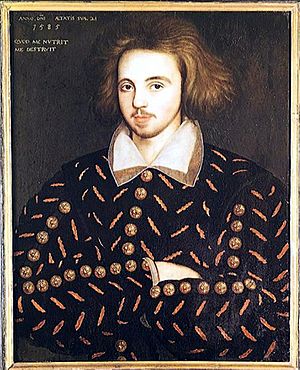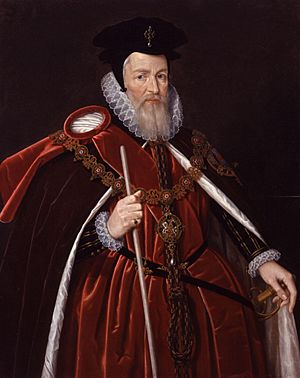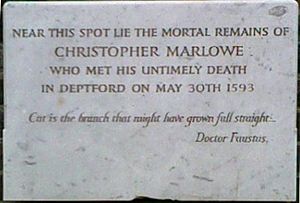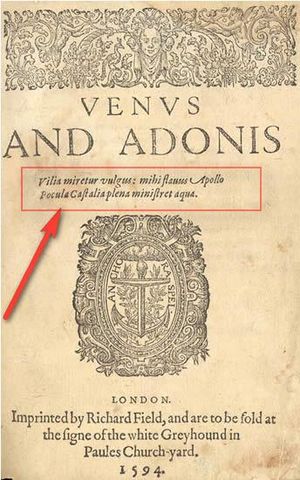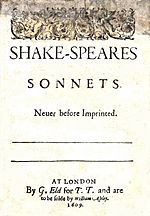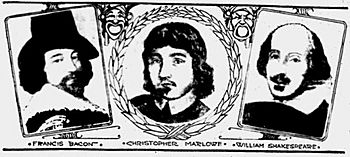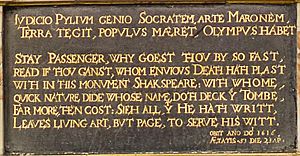Marlovian theory of Shakespeare authorship facts for kids
The Marlovian theory is a big idea that says the famous writer Christopher Marlowe actually wrote the plays and poems we know as William Shakespeare's. This theory also suggests that Marlowe didn't really die in Deptford in 1593, as history books say. Instead, his death was faked.
People who believe this theory are called Marlovians. They point to strange things around Marlowe's reported death. They also note how much Marlowe's writing style influenced Shakespeare's work. It's also interesting that Marlowe and Shakespeare were born only two months apart. But Shakespeare's name first appeared on a published work, Venus and Adonis, just a week or two after Marlowe's supposed death.
Most experts disagree with this theory. They say that 16 people officially confirmed Marlowe's death in 1593. Everyone at the time seemed to believe he was dead. Also, there's no direct proof that Marlowe lived past 1593. While there are similarities in their works, experts say Marlowe's writing style is too different from Shakespeare's. Things like his vocabulary and how he wrote comedy are not the same. Most Shakespeare scholars believe that official documents and writings from other poets prove William Shakespeare of Stratford wrote the works. They see the Marlovian theory as a less common idea.
Contents
Who Believes the Marlovian Theory?
In 1819, a writer for The Monthly Review wondered if 'Christopher Marlowe' was a pen name Shakespeare used. This idea grew, with some suggesting that Shakespeare "disappears" when Marlowe appears. Then, Shakespeare "re-appears" after Marlowe's death. They thought one person wrote both Marlowe's and Shakespeare's works.
Wilbur G. Zeigler was the first to suggest that Marlowe mainly wrote Shakespeare's works. He wrote about it in his 1895 novel, It was Marlowe. This book imagined how the fake death might have happened. In 1916, Henry Watterson, a newspaper editor, also supported the theory with a fictional story. The first essay just about this topic was by Archie Webster in 1923.
Later, Calvin Hoffman (1955) and A.D. Wraight (1994) wrote important books supporting the idea. Hoffman focused on similar words and ideas, called "parallelisms," between the two writers. Wraight looked into what she saw as the real meaning of Shakespeare's sonnets.
In 2001, filmmaker Michael Rubbo made a TV film called Much Ado About Something. It explored the Marlovian theory in detail. In 2009, the International Marlowe-Shakespeare Society was created. It continues to share the theory with the public.
What Happened to Marlowe?
Most scholars agree that Christopher Marlowe died on May 30, 1593. He was stabbed above his right eye by Ingram Frizer. They had been eating together with two other men, Robert Poley and Nicholas Skeres. They were at the Deptford home of Eleanor Bull, a woman who hosted private meetings.
Over time, the Marlovian argument about Marlowe's death has changed. At first, they thought his death must have been faked because they believed he later wrote as Shakespeare. Then, they questioned the details of the official investigation. Now, they claim the situation around his death suggests it was faked. This is true whether he went on to write Shakespeare's plays or not.
The Official Investigation
On June 1, 1593, two days after Marlowe's reported death, an investigation was held. William Danby, the Queen's personal investigator, and a jury of 16 men decided it was self-defense. Records show Marlowe was buried that same day in Deptford. His exact grave location is unknown. The Queen pardoned Frizer just four weeks later.
Most scholars now agree that the official story was not entirely true. They think Marlowe's stabbing was a murder, not self-defense. Many authors who have written about Marlowe's death believe the witnesses were probably lying. They often suggest it was a political murder. This is because the witnesses, Robert Poley and Nicholas Skeres, worked for the government.
However, there is little agreement on why the murder happened or who was behind it. Marlovians say this confusion comes from asking the wrong question. They believe people should ask why those specific people met at that place on that day. The Marlovian theory argues that the most logical reason was to fake Marlowe's death.
Why Marlowe Might Have Faked His Death
It's generally believed that Marlowe worked as a secret agent. He might have worked for Sir Francis Walsingham or the Cecils (Lord Burghley and his son Sir Robert Cecil). So, he could have had powerful friends who could help him fake his death.
Marlowe was also in serious trouble at the time. People were accusing him of convincing others to not believe in God. Whether true or not, he was suspected of writing a book that went against the government. For such crimes, he would likely have been tried and executed. In the two months before, three people had been executed for similar reasons. Marlovians believe Marlowe had a strong reason to agree to some way of escaping.
Most writers who study Marlowe agree that the accusations against him were very serious. It's surprising that he was still free on May 30, despite an arrest warrant on May 18. Whatever the reason, this gave him the chance for a faked death to be planned and carried out, if the Marlovians are correct.
The People Involved
Marlovians point out that everyone involved in the incident seemed connected to Marlowe's friend Thomas Walsingham (Frizer and Skeres) or his employers the Cecils (Poley, Bull, and Danby). They note that the four men stayed together for 10 hours. This seems like a long time if they just wanted to get rid of Marlowe. Marlovians suggest the most likely reason for the meeting was to save him from danger. They claim that faking his death fits the known facts better than any other idea.
The Investigator's Role
Recent findings suggest the investigation might have been illegal. The local County Investigator should have overseen it. The Queen's Investigator, William Danby, should only have been involved if the crime was close to the Queen's residence. And then, both should have run it together. Marlovians argue that Danby doing it alone suggests he knew about the killing before it happened. They say he "happened" to be there to take charge. If there was a trick, Danby must have been involved, likely with the Queen's quiet approval.
The Body
Marlovians argue that if Frizer, Poley, and Skeres could lie about what happened, they could also lie about the body's identity. They claim that even though the men said it was Marlowe's body, it might have been someone else. They were the only ones there who could identify him.
If a death is faked, a substitute body is needed. David A. More suggested a possible "victim." The night before the Deptford meeting, John Penry, who was about a year older than Marlowe, was hanged. He was executed for writing against the government, just two miles from Deptford. There is no record of what happened to his body. William Danby, the same investigator, would have decided what happened to Penry's body. Those who disagree with the theory say it would have been too obvious that the body had been hanged. But Marlovians say Danby, being in charge, could have easily hidden such evidence from the jury.
However, this idea is not widely accepted by academics. Most scholars, like Stanley Wells, believe that Marlowe truly died in 1593. Wells wrote that the official documents about Marlowe's death make it "one of the best recorded episodes in English literary history."
Marlowe and Shakespeare's Works
The "Shakespeare" Idea
The common view, called the Stratfordian view, is that "Shakespeare" was William Shakespeare from Stratford-upon-Avon. He moved to London, became an actor, and part-owner of the Lord Chamberlain's Men acting company. This company owned the Globe Theatre and the Blackfriars Theatre. Marlovians, however, argue that this William Shakespeare was just a "front" for the real author. They say any proof for him as the author can be explained by their theory.
A key point for Marlovians is that William Shakespeare's name first appeared on a work 13 days after Marlowe's supposed death. Shakespeare's first published work, Venus and Adonis, was registered without an author's name in April 1593. It seems to have been sold with his name by June 12.
Most Shakespeare scholars completely reject the Marlovian theory. Stanley Wells explains why: "All of this [evidence of Marlowe's death] makes the idea that he went on to write Shakespeare's works ridiculous. He would have left no sign of his existence for at least twenty years. During this time, he supposedly created masterpieces that no one in the busy theater world knew were his. He also let his Stratford friend get all the credit and rewards."
Clues in the Writing Style
Writing Style
This is a much-debated topic. Calvin Hoffman especially pointed out "parallelisms" between the two authors. For example, in Marlowe's "Jew of Malta," Barabas says: "But stay, what star shines yonder in the East? / The lodestar of my life, if Abigail." This is very similar to Romeo's famous line: "But soft, what light through yonder window breaks? / It is the East, and Juliet is the sun!" when Juliet appears on her balcony. There are many such examples. The problem is knowing if they are by the same author or if Shakespeare simply copied Marlowe. However, Marlowe is the only writer Shakespeare seems to copy so much. Everyone agrees Marlowe greatly influenced Shakespeare.
Scientists use stylometric approaches to find writing patterns unique to an author. These methods have been used to argue that Marlowe could not have written Shakespeare's works. But when these patterns are tracked over time, Marlowe's writings fit where Shakespeare's would have been if he had written before the 1590s. On the other hand, stylometry is better at showing when two works are not by the same person than when they are.
Marlovians suggest that differences in content are expected. If Marlowe faked his death, his life would have changed a lot. He would have new places, experiences, interests, and friends. He might even have had new political goals or worked with new people, like Shakespeare himself.
Shakespeare's Sonnets
Many Shakespeare scholars today don't believe the Sonnets are about Shakespeare's own life. Marlovians say this is because there's no real link between the Sonnets and what we know about Shakespeare's life. The only connections are references to his name "Will" and a possible play on "Hathaway." In contrast, Marlovians claim that if Marlowe survived and was exiled, the Sonnets reflect what happened to him.
For example, in Sonnet 25, a Marlovian might say something unexpected happened to the poet. This event stopped him from getting "public honour and proud titles." It also seems to have led to forced travel far away, maybe even overseas. This journey seems to be a one-time event. Whatever it was, it's linked to him being "in disgrace with fortune and men's eyes" and his "outcast state." The poet also says he was "made lame by fortune's dearest spite." Marlovians see each of these parts as reflecting Marlowe's alleged faked death and later life.
Marlovians also claim their interpretation allows more of Shakespeare's words to be taken literally. For instance, "a wretch's knife" (74) means a real knife, not just a symbol. An "outcast state" (29) means truly being an outcast, not just feeling disliked. And when he says his "name receives a brand" (111), it means his reputation was permanently damaged. However, Jonathan Bate argues that "Elizabethans did not write coded autobiography."
Clues in the Plays
Faked death, disgrace, being sent away, and changed identity are common themes in Shakespeare's plays. Stephen Greenblatt notes that in his plays, a sudden disaster often turns a happy situation into terror and loss. This loss is not just about money, but also a loss of who someone is. Ending up in an unknown place, without friends, often means changing one's name and social status.
Marlovians see how this connects to their theory. But they don't look for many parallels between Marlowe's life and these stories. They believe the plays have so many plot ideas that parallels can be found with many people. However, they do point out some parts that are hard to explain unless they were inside jokes for people who knew a secret.
For example, in The Merry Wives of Windsor (3.1), a character sings Marlowe's song "Come live with me..." But he mixes it with words from Psalm 137, "By the rivers of Babylon...", a famous song about exile. Why would Shakespeare include that mix?
Also, in As You Like It (3.3), a character says: "When a man's verses cannot be understood... it strikes a man more dead than a great reckoning in a little room." This seems to refer to Marlowe's death. Many of Shakespeare's biographers are puzzled by this. Agnes Latham asks, "nobody explains why Shakespeare should think that Marlowe's death by violence was material for a stage jester."
Outside Evidence
The main argument against the 'faked death' theory is that there's proof Marlowe died, but no clear proof he survived. So far, the only outside evidence offered is claims that someone alive after 1593 must have been Marlowe. Or, people claim to find hidden messages on Shakespeare's grave.
Who Was Marlowe After 1593?
Some people have been suggested as the "real" Christopher Marlowe after 1593. These include Hugh Sanford, who lived with the Earl of Pembroke, and a Christopher Marlowe (also known as John Matthews) who appeared in Spain in 1602. Also, a spy named Monsieur Le Doux worked as a "French tutor" in 1595. Henry Watterson wrote a fictional story about an Englishman named Marlowe who died in Italy in 1627. This led some Marlovians to search Italian records, but they found no proof. If Don Foster is right that the "begetter" of the Sonnets was the poet himself, then Marlovians suggest "Mr. W.H." might not be a mistake. It could mean Marlowe used an identity with those initials in 1609.
Hidden Messages
Many people who question Shakespeare's authorship look for hidden messages. These can be found in things like acrostics (where the first letters of lines spell a word) or rearranged letters. This approach is less popular with Marlovians.
However, Peter Bull claims to have found a hidden message in the Sonnets. Also, two Marlovians, William Honey and Roberta Ballantine, believe the famous four-line "curse" on Shakespeare's grave is an anagram (rearranged letters). They came up with different messages. Anagrams can hide messages, like claims of who wrote something. For example, Galileo and Huygens used them. But they are only useful if the original writer confirms the answer.
Another way to find hidden messages is by interpreting parts that have double meanings. Writers of that time often used irony or double entendre. For example, traditional scholars often use poems in the First Folio as proof for Shakespeare. Jonson's poem describes Shakespeare's portrait as having "hit his face" well. His praise calls Shakespeare "sweet Swan of Avon." And Digges's line refers to when "Time dissolves thy Stratford monument."
Marlovians say these can be interpreted differently. The "face" could mean an "outward show" or "disguise."
When Jonson writes "Swan of Avon," it could mean the Avon river in Stratford. Or it could refer to the Avon in Wiltshire, where the people the First Folio was dedicated to lived. And when Digges writes "And Time dissolves thy Stratford monument," some Marlovians argue it means Time will "solve, resolve or explain" it. This becomes important because the poem on Shakespeare's monument ("Stay Passenger...") might be a puzzle. It could be asking us to solve who is "in" the monument "with" Shakespeare. The answer seems to be "Christofer Marley" (how Marlowe sometimes spelled his name). The poem would then suggest that with Shakespeare's death, Marlowe no longer has a "page" to share his wit.
The Hoffman Prize
Calvin Hoffman, who wrote The Man Who Was Shakespeare (1955), died in 1988. He was still sure that Marlowe wrote Shakespeare's works. He wanted the theory to continue. So, he left a lot of money to the King's School, Canterbury (where Marlowe went to school). They use the money for an annual essay competition on this topic. As of 2019, the prize was about nine thousand pounds (UK). A famous Shakespeare scholar judges the prize. Even though Hoffman wanted to support the Marlovian cause, the winning essays usually follow the traditional view.
In Fiction
Besides the stories by Zeigler and Watterson, others have used the Marlovian theory in fiction. Rodney Bolt's History Play (2005) shows Marlowe as the true author of Shakespeare's works after faking his own death.
In The Marlowe Papers (2012) by Ros Barber, Marlowe's "death" is a trick. He then writes plays under the Shakespeare name. This novel won the Hoffman Prize in 2011.
In the 2012 movie Only Lovers Left Alive, Marlowe is a vampire. He mentions he wrote Hamlet and wishes he had based the character on his son-in-law.
Ben Elton's 2016 TV show Upstart Crow flips the theory. In the show, Shakespeare writes plays for Marlowe (like Doctor Faustus) to help Marlowe keep his cover as a playwright.
See also
 In Spanish: Teoría Marlowe para niños
In Spanish: Teoría Marlowe para niños


